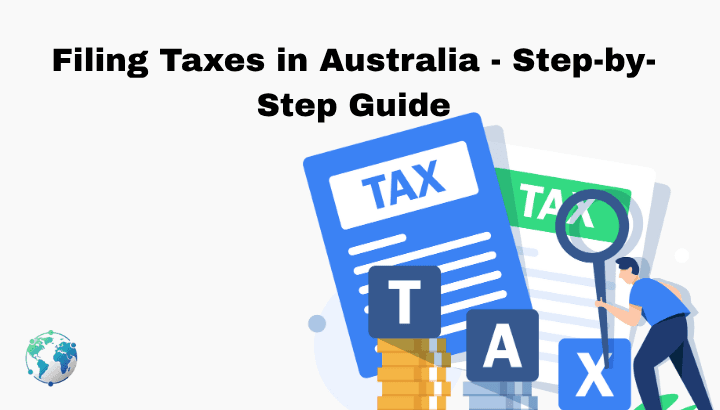Filing your taxes in Australia doesn’t have to be hard or stressful. Whether it’s your first time or you’ve done it before, knowing how the tax return process works in Australia can help you follow the rules, avoid mistakes, and maybe even get a good tax refund.
In this easy step-by-step guide, we will show you how to file taxes in Australia, when everything is due, what document you need, and how to get the most out of your refund. This guide is great for individuals, employees, freelancers, and sole traders who want to know How to File a Tax Return in Australia 2025 without any trouble.
Who Needs to File a Tax Return in Australia?
You must file a tax return with the Australian Taxation Office (ATO) if you:
- Earn income more than the tax-free threshold, which is $18,200 as per 2025 tax rule.
- Are a resident for tax purposes and paid tax on any type of income.
- Got any government payments or center government benefits.
- Are a foreign resident living for more than 6 months and who earned Australian income.
Once you understand the eligibility for tax filing in Australia, make sure not to miss the deadline, because this can lead to unnecessary penalties and you have to pay extra money for that.
Here are some important dates to remember:
- 1st July: The financial year finishes, and you can start getting ready to do your tax return process.
- 31 October: The last date to send your tax return if you are doing it yourself.
- Later than 31 October: If you use a registered tax agent, you might get extra time to lodge your tax return.
Step-by-Step: How to File a Tax Return in Australia 2025
Step 1: Gather Your Documents
Start by gathering all the documents you will need to do your tax returns. Here’s what to look for:
- PAYG payment summary: This is a group certificate which shows how much money you earned from your job and how much tax was taken out
- Bank interest statement: Shows how much interest you earned from your savings accounts.
- Private health insurance statement: Confirms you had health covers, which may affect your tax.
- Centrelink payment summaries: If you received government payments, you will need this summary.
- Receipts for deductible expenses: Keep receipts for things like work-related costs that you can claim to reduce your tax.
If you’re a freelancer or self-employed, don’t forget to include:
- Business income and expense record: A list of what you earned and spent for your business.
- ABN (Australian Business Number): your unique business number for tax purposes.
- GST records: if you’re registered to GST, include those records too.
Step 2: Sign-up or Log-in to Your myGov Account
myGov is a secure online platform provided by the Australian government, where you need to create or log in to your account for tax filing and link it to ATO (Australian Taxation Office). This makes the process easier and faster. With myGov, you can:
- Pre-filled information from employers and banks, where your income and bank details are already filled in.
- Medicare and Centrelink records, so that you can easily see your health and government support details.
- Get access to your income statement and tax history.
This is the easiest and most popular way to lodge your tax return online.
Step 3: Choose a Lodgement Method
You can lodge your return in one of these three ways:
- Online through myGov: It is the easiest and fastest way for most people, especially if you’re an individual who is filing for tax returns.
- Through a registered tax agent: It is best if your tax situation is more complicated and a registered tax agent can help you get everything right.
- Paper tax return form: it is a manual process and slow, which is really not recommended because it takes a lot of time.
For most Australians, lodging through myTax via myGov is the quickest, easiest, and free platform.
Step 4: Fill Out Your Tax Return
When you use myGov and myTax, the ATO will auto-fill a lot of your info automatically, like from your job, bank, and centrelink records. But it’s important to check and make sure everything is right, including:
- Income from all sources to make sure you have included money from all jobs, investments, or any other income.
- Deduction you want to claim.
- Offset and rebates, means if you’re eligible for any extra tax reductions or refunds
- Private health insurance details to make sure your health info is correct or not.
You will have to manually enter any deductions or expenses, so keep all your receipts ready when needed.
Step 5: Claim Tax Deductions
Claiming tax deductions can help you get a bigger refund or pay less tax. These are costs you paid that are related to earning your income. Here are some common ones:
- Work related expenses like tools, uniforms, or using your car for work purposes only.
- Home office costs if you work from home and you can claim part of your electricity, internet, or office equipment.
- Phone and internet usage for work.
- If you gave money to a registered charity, you can claim it as a deduction too.
- You can claim what you paid a tax agent to help you with last year’s tax return.
Always check the ATO’s guidelines to see which deduction you can claim for your type of job.
Step 6: Submit Your Tax Return
Once you have checked everything is correct and applicable, submit your return and the ATO usually finishes checking it in 2 to 3 weeks.
After all that is done, you will either get:
- A tax return, which tells you paid too much tax and the ATO will give you the extra money back
- A tax bill, which tell you didn’t pay enough tax and you will need to pay the amount you owe.
Step 7: Check Your Notice of Assessment
After you lodge your tax returns, the ATO will send you a Notice of Assessment. This shows important details about your tax return. Make sure to read it carefully and check that everything is correct. It will include:
- Taxable income of the total income you were taxed on.
- Tax withheld, the tax your employer already took out of your pay.
- Refund or amount payable, shows if you are getting money back or if you owe the ATO.
Tips to Maximise Your Tax Refund
If you want to boost your tax return in Australia, you need to follow some smart tricks. Here’s how:
- Keep digital receipts of everything in an app or cloud folder.
- Use ATO tools and try the ATO deduction calculator.
- Be honest and accurate with your claims to avoid audits.
- Invest in a tax agent instead of making silly mistakes, especially if you’re self-employed or a contractor.
- Claim work-from-home expenses, especially relevant post-COVID.
Conclusion
Filing your tax return in Australia doesn’t have to be hard. If you stay organised, use myGov, and keep a good record, you can lodge your taxes with confidence and maybe get a nice refund.
Want to maximize your tax refund in 2025? Stay up to date, plan ahead, and ask a registered agent for help if you need it.
FAQs
When is the deadline to lodge a tax return in Australia?
The deadline of sel-lodging is 31 October. If you use a registered tax agent, you may get an extension.
Can I lodge my tax return online?
Yes, via myGov using the ATO’s myTax system. It’s fast, free, and simple.
What happens if I miss the tax deadline?
Yes may face penalties or interest. Contact the ATO or a tax agent immediately if you’re late.

